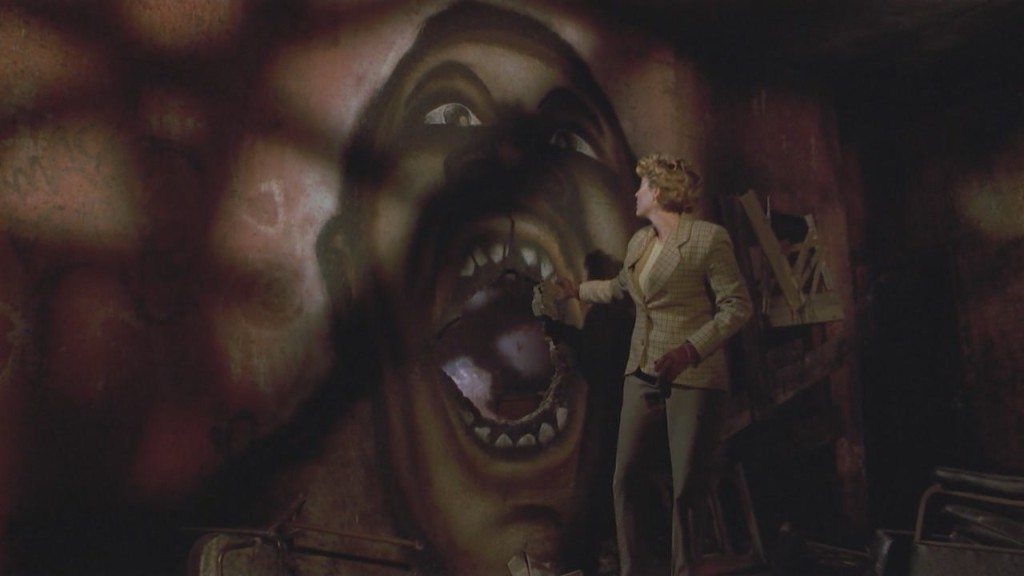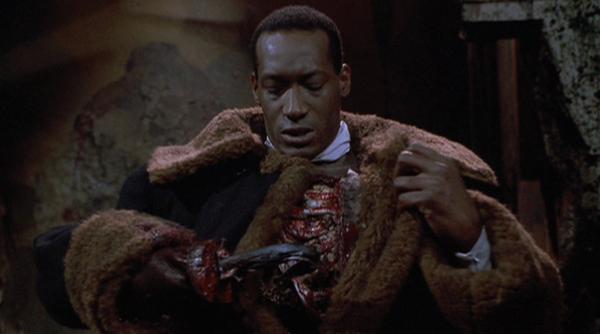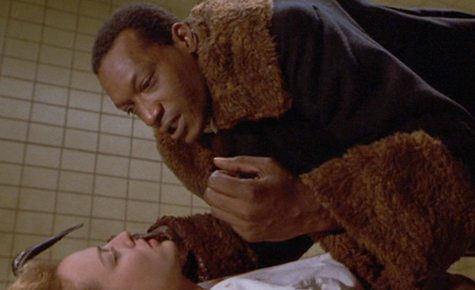As a general rule, it’s never a good thing to look into a mirror and repeat anything five times.
Sure, Stuart Smalley may disagree, but doggone it, that many “good enoughs,” “smart enoughs,” and “people like mes” are not only superfluous, but–dare I say it–disingenuous as well.? Nobody is really that good enough, that smart enough and me-liked to the power of five.
And I don’t care if you’re just repeating the Gettysburg address or running lines for your Summerstock production of “A Midsummer Night’s Dream,” there is no–I repeat, NO–need to repeat (you read that right) anything in front of a mirror five times.
Especially not the name of “Candyman.”
That was the title Bernard Rose chose when he adapted Clive Barker’s short story, “The Forbidden,” for the Big Screen in 1992.? In Rose’s version, the hook-handed, honeybee-riddled corporeal apparition known as Candyman haunts Chicago’s Cabrini-Green Projects like the misbegotten cousin of Bloody Mary, popping up whenever a skulking skeptic called him out.? It’s a bloody good twist on the classic urban legend, loaded with jump scares (a bunch that have nothing to do with the horrific villain–can I just say that I am not a fan of dogs, by the way?? Especially whatever breed it is that jumps out barking as ominous background music builds to a crescendo and you try to swallow a man-paw of popcorn).? The ending falters, but have no fear: two sequels provide the opportunity to go out on a higher note.? Still, as is usually the case, the original is the best overall picture.
And how sweet it is.
So…would you rather be disemboweled by a rusty hook or stung to death by hordes of angry honeybees?
Classic question, of course; one that’s undoubtedly challenged man since the dawn of the age.? Or at least since 1992.
That’s when Tony Todd solidified his place in horrordom iconography as the mystical, mirror-hopping madman, Candyman.? It was the first time a black male carried all the kills, joining the ranks of Jason, Freddy and Michael as a horror heavyweight.? Not since George Romero’s Night of the Living Dead had a black man featured so prominently in a fright film (ironically, that heroic role of Ben, played by the uber-talented Duane Jones, was picked up by Todd in the 1990 Tom Savini-directed NOTLD remake).? Candyman was a fresh take on classic urban mythos and resonated with fans and critics not only for its scares, but also for its social commentary.
When very white, very uptown grad student Helen Lyle (Virginia Madsen) infiltrates the crime-ridden halls of Chicago’s Cabrini-Green housing projects, she wonders if she’ll find anything more terrifying than the gang bangers.? Of course, she’s hoping to–despite her skepticism–since she’s writing a thesis on urban legends.? She’s come to the projects to research a Bloody Mary-like ghost named Candyman, who terrorizes tenants when they say his name five times in front of a mirror.

He was born the son of a slave, but raised in high society.? A talented artist, he was requisitioned as an adult to paint a portrait of a prominent white landowner’s daughter.? When the two of the fell in love and had a child, the girl’s father dealt out a harsh punishment.? Gathering a lynch mob, the father had the painter’s hand sawed off and replaced with a hook.? To finish the job, the mob stole honey from an apiary and smeared it on the painter’s body.? They huddled around him, chanting “Candyman” as a colony of bees stung him to death.

While scouring the hidden halls of Cabrini-Green, Helen discovers graffiti-soaked shrines stocked with candy, apparently to appease Candyman, who’s almost become a cult hero to bangers and taggers.? Tenants recounts stories of Candyman’s exploits–the murder of another renter who was mauled after he literally tore through the walls of her apartment; the brutal end of a young boy who dared summon him while in a first-floor community bathroom.? None of it scares Helen off his scent, not even when a gang boss poser roughs her up with his own hook.? Undeterred, she returns to the projects, trying once again to find legitimate evidence of the Candyman.

She finally gets it when one of the tenant’s infants goes missing.? Meddling outsider that she is, Helen becomes the prime suspect.? But when the Candyman finally appears, she learns the truth: he has stolen the infant and will only trade his life for hers.? He demands that she sacrifice herself in order to save the baby and a mystical, murderous game of kill-or-be-killed ensues.? And Helen soon learns that it’s no coincidence that she sought out the Candyman in the first place…

There’s enough scares to keep your dukes up and plenty of creepy crawlies for anyone who is remotely heebie-jeebie phobic.? Tony Todd is every bit as menacing as the classic slashers and his deep baritone (a missing element from the likes of Jason and Michael) makes him even more intimidating.
The story pokes at the uneasy tension between the haves and have-nots and forces the audience to meet “those peoples’ problem” head-on.? Madsen was reportedly tenuous about the script, wondering if the class/race subplots, though subtle, would incite backlash.? But judging by the overall success of the franchise, Candyman was scary, but not too agenda-driven to scare audiences away.
What Candyman does very well is feed us a healthy message on the about-face possibilities of Salvation.? Initially, Helen wants so badly to disprove Candyman’s existence that she takes foolish risks.? Later, after she’s gotten her first-hand glimpses at his Cabrini-Green folklore, she wants to confirm his existence so much so that she is willing to sacrifice whatever it takes to get close to him–and finish him for good.
The comparison between Candyman and a Messianic figure (especially the Messiah Himself) is not truly applicable. ?Still, this film?does have a strong?thematic allegory on devotion.? Much like Saul’s rejection of Christ, Helen doubts and even eschews the possibility of Candyman until she begins to see more and more evidence of his existence.? It is not until she experiences him first-hand, like the Damascus-seeking Paul, that she accepts and believes.?? And just as Paul became fanatical in his devotion to serve, she becomes just as radical, but in her mission to destroy.
As believers, we must be just as passionate, but careful to ensure that our discipleship breeds Paul’s love and not Helen’s destruction.? May we approach others with open hands ready to serve, not sharpened hooks, readied to pick them apart.? May we speak with genuine tongues, avoiding honeyed, coercive versions of the “Gospel.”? And may we constantly strive to invite others to see what all the buzz of Christianity is about.
After all, Jesus is pretty much the bee’s knees.





